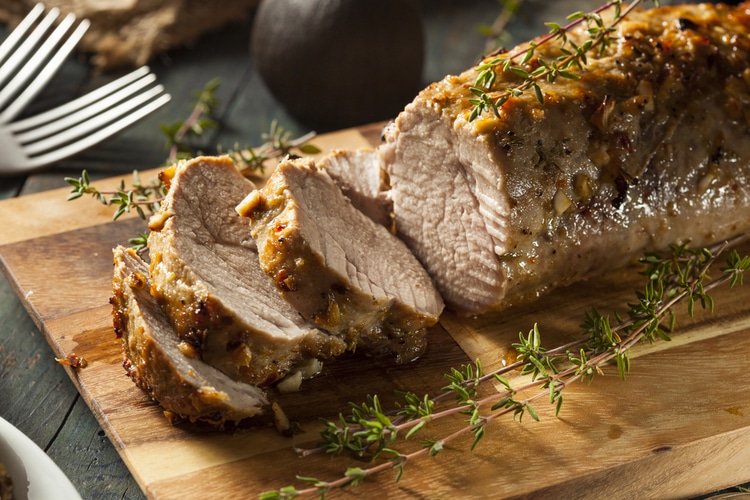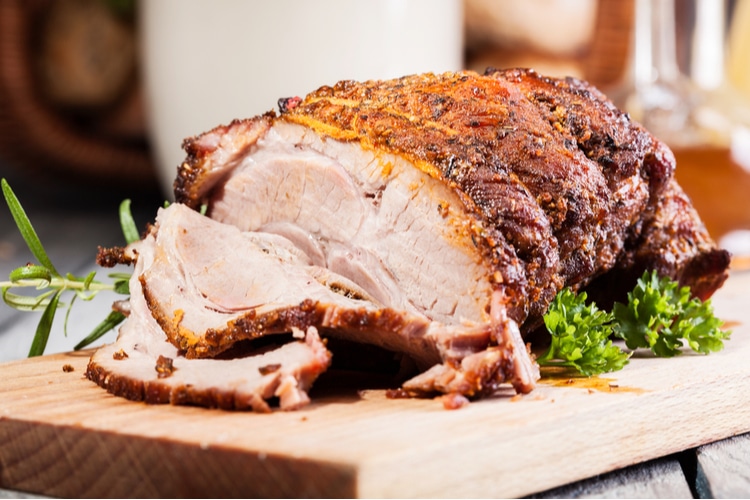The meat aisle at the grocery store can have a confusing selection of chops, loins, roasts, and other products.
Many people compare pork loin vs pork shoulder based on their taste preferences and what they enjoy the most, but each type of meat lends itself to specific recipes more than others.
Let’s look at how they compare so you can choose the best one for your cooking needs.
Difference Between Pork Loin and Shoulder
The main difference between pork loin and pork shoulder is that pork loin is the tenderest, leanest cut of pork, while pork shoulder is a tougher cut with more fat.
Appearance: Pork loin is lean, while pork shoulder has visible fat marbling.
Price: Pork loin is more expensive, while pork shoulder usually costs less and makes cheaper products like ground pork.
Cooking time: Pork loin benefits from shorter cooking times, while pork shoulder does better with longer and slower cooking to create tender meat.
Products and Uses: Pork loin is usually sold as a roast and bone-in or boneless pork chops, whereas pork shoulder comes in different roasts and ground pork. Shredded and pulled pork often comes from pork shoulder cuts.
Pork Loin vs Pork Shoulder Comparison Table
Here’s a table to demonstrate the difference between pork loin and pork shoulder.
| Pork Loin | Pork Shoulder |
| From the top between the shoulder area and back legs | From the shoulder, between the shoulder blades |
| Leanest cut of pork | Lean meat marbled with fat |
| The most tender cut of pork | Contains connective tissue, making it tougher |
| Can end up dry with too much cooking | Less likely to dry out because of fat content |
| Pork chops come from this cut | Often sold as pork butt or ground pork |
| When sold as a roast, it can be called pork roast, pork loin roast, pork center rib roast, or center loin roast and is typically boneless | Sold as blade pork roast with the blade intact or arm roast when it contains arm meat |
| A pork loin roast typically weighs 2 to 4 lbs | A pork shoulder roast weighs 4 to 10 pounds |
| Shorter cooking times needed to keep it tender | Long cooking times at slow temps creates fork-tender meat from this tougher cut |
| Often served alone as an entrée | Often used as part of other recipes |
| Needs to reach 145 degrees Fahrenheit in the center for safety | Also needs to be 145 degrees, but 180-190 degrees is best for making pulled pork |
Can You Substitute Pork Loin for Shoulder?
Yes, you can substitute pork loin for pork shoulder and vice-versa in most cases. The taste is similar in both cuts of meat. You’ll only need to change the recommended cooking times to avoid overcooking pork loin and undercooking pork shoulder.
In dishes that require pan-frying or grilling, pork loin is better. You can cut a pork shoulder roast into slices, but the meat will remain fairly tough because pan-frying and grilling involve shorter cooking times than roasting.
Pork shoulder is the better cut for pulled pork, but you can use pork loin if you wish. Instead of roasting the pork, use a slow-cooker to retain the juice and make the meat more tender.
For any dish that calls for pre-cooked pork, such as soups or casseroles, cook the cut you have in the way you prefer before adding it. Pork cuts are interchangeable in recipes like those.
Related Comparison: Chicken Tenderloin vs Breast
What is Pork Loin?

Pork loin is a cut of meat from above the shoulder. It extends between there and the back leg on each side of the pig. Sometimes called pork sirloin, this cut is one of the more expensive cuts of pork.
While figuring out the difference between pork loin and pork shoulder, don’t confuse pork loin with pork tenderloin. Those are two different cuts of meat. Pork tenderloin is a long strip of meat from around the spine rather than down the side.
A pork loin roast is a shorter chunk of meat that usually weighs 2 to 4 pounds with a layer of fat on the top. Pork tenderloin is typically about one pound and much longer than its thickness. One can’t be substituted for the other unless it’s a recipe that calls for pre-cooked chunks or shreds of meat.
Pork loin is the leanest, tenderest cut of meat from the pig. You’ll usually find it sold as boneless or bone-in pork chops or a roast. The pork loin is typically boneless for easier slicing when sold as a roast.
The roast comes with a layer of fat on top, known as a fat cap. Despite this fat layer, the meat is lower in fat than other pork cuts because it contains little fat inside.
Even though pork chops come from the pork loin, you’ll usually pay less per pound for a pork loin roast than for pork chops.
How to Use Pork Loin
When you buy pork loin, you can keep it in the refrigerator for up to three days before cooking. If you aren’t going to cook it within three days, store it well-wrapped in the freezer for up to six months.
To thaw it, put it in the refrigerator about 24 hours before you plan to cook it. It will turn out better if you cook it from a thawed state rather than frozen.
Pork loin is such a tender cut of meat that it’s often the main entree of a meal. It’s the kind of cut that stands alone and doesn’t need to be part of a recipe or covered in sauces to be delicious.
Oven roasting is the preferred way to cook a pork loin roast, or you can slice it into chops for pan-frying or grilling. If you leave the roast at room temperature about half an hour before cooking, it will cook more evenly.
You can pan-sear the roast to brown the sides to give it a better appearance and seal in the juices before you cook it.
The cooking time is typically 20 to 25 minutes per pound at 350 degrees, but the more important measure is that it reaches at least 145 degrees Fahrenheit inside. The center may appear slightly pink, but that’s fine as long as it reaches the proper temperature.
What is Pork Shoulder?

Pork shoulder is the pig’s shoulder and the meat between the shoulder blades. It’s usually one of the more inexpensive cuts of pork you can buy. Pork shoulder is a visibly fatty cut of meat, with thick lines of marbled fat throughout.
You’ll usually only find pork shoulder sold as a bone-in or boneless roast. These roasts can weigh anywhere from 3 to 5 pounds on the low end when they’re boneless and up to 10 pounds on the high end. The heavier cuts contain the shoulder blade as a pork blade roast.
Pork butt or pork butt roast is the thickest, fattiest part of the shoulder. If the roast is called pork shoulder, it’s typically from the thinner shoulder section. It will still contain plenty of fat but less than a pork butt.
A pork arm roast is a pork shoulder roast containing meat from the leg below it. Ground pork usually comes from this inexpensive cut.
How to Use Pork Shoulder
Like all meat, pork shoulder is best if you cook it as soon as possible after you buy it. You can keep it for up to three days in the refrigerator. To store it for more than three days, wrap it well and keep it in the freezer for up to six months.
A five-pound roast will take about 24 hours to thaw in the refrigerator. Plan on an additional 24 hours for every five pounds of meat. Don’t cook it from frozen to avoid overcooking the outer layers and drying them out.
Let it rest at room temperature for about half an hour for more even cooking. You can cook the roast whole, cut it into small or large chunks for pulled pork or use in recipes, or grind it for ground pork dishes.
Searing creates a nice appearance and seals in juices. You can do this on the stovetop, but it’s easier to do under the broiler because pork shoulder roasts are larger than many other cuts.
As with all pork, the center of the meat needs to reach 145 degrees Fahrenheit to make it safe to eat, so use a meat thermometer when you cook a whole roast. One big difference between pork loin and pork shoulder is the cooking method.
Because pork shoulder is a tougher cut of meat, don’t dry roast it. Braise it with liquids in the pan, whether you roast in the oven or use a slow cooker. The roast will cook in about 30 to 45 minutes per pound at 350 degrees.






